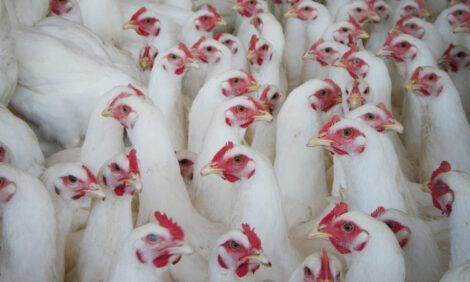



Marek's Disease - the Story behind the Headlines
With recent outbreaks of Marek's disease occurring, this article by poultry veterinarian, Stephen Lister, provides a timely reminder to producers that Marek's disease is a hidden menace. It was published by DuPont Animal Health Solutions.- Marek’s disease may not grab the headlines but it continues to negatively impact on flock health and economics
- Marek’s disease is a very stubborn virus
- Marek’s disease is capable of causing clinical disease and mortality
- Marek’s disease can also damage the immune system leading to poor performance, poor response to other diseases and their vaccinations
- The highly resistant virus is stable for 65 weeks in the un-cleaned environment surviving in poultry feathers, dust, and dander
- Vaccination programmes are challenging to implement
- Vaccination alone will NOT control the effects of this virus
- Keeping the viral challenge low for the new crop is key
- Highly effective, four stage Terminal cleaning and disinfection programmes using a proven virucidal disinfectant such as DuPont Virkon® S is recommended.
It is easy to get distracted by the headline grabbing poultry health issues of avian influenza, Newcastle disease and Salmonella. Whilst these may well be the most pressing disease problems for our industry, the danger is that concentrating all time and resources on them tends to ignore those diseases that may be having a chronic and significant impact on performance and profitability, day in and day out.
With outbreaks of Marek’s disease occurring in 2007 this article provides a timely reminder to producers that Marek’s disease is a hidden menace. It is caused by a very resistant and hence very persistent herpesvirus which causes infection in chickens and, to a lesser extent, turkeys1.
Control of Marek’s disease infection depends on a combination of effective vaccination and high quality cleansing and disinfection of poultry houses. Any deficiencies in either area can tip the balance in favour of the virus rather than the bird.
Marek’s disease was first described over 80 years ago as a condition causing paralysis of the legs and wings due to inflammation of the nerves. The condition was then known as fowl paralysis. In the 1920s and 1930s, an association with internal tumours in various organs such as liver, spleen, kidneys and lungs was made. The disease became a significant limitation to the success of the developing layer and broiler industries in the 1960s due to some very high mortality rates of up to 80%!
The appearance of successful live vaccines in the late 1960s was one of the most significant factors in enabling the poultry industry to develop to the extent that it has today.
Disease can manifest itself in a number of ways related to the type of bird, when the flock became infected, general hygiene and biosecurity on the rearing and laying farms, the presence of other diseases and the vaccines used or the strain of virus involved.
Signs and Symptoms
In laying stock, producers may suspect Marek’s disease if they identify paralysed birds; often with one leg trailing or wings dropped. In other cases, there may simply be higher than expected mortality or a number of birds wasting away.
In broilers, losses are mostly due to high condemnation rates at slaughter predominantly from the cutaneous (skin) form of Marek’s disease. In free range broilers or birds taken to heavier weights, mortality may result from internal tumours, predominantly of liver and spleen.
In turkeys, acute mortality can be associated with internal tumours of liver and spleen often where turkeys have been reared in the same accommodation as infected chickens.
Even where there is no acute mortality, the affects on internal organs can lead to significant damage to the immune system. This can be associated with suboptimal performance and clinical outbreaks of other diseases such as coccidiosis, heavy worm infestations or viral diseases such as Gumboro disease. The impaired immune system is also unable to respond to routine vaccinations and hence will leave flocks unable to resist a whole range of disease challenges which affect performance.
All this means that if the background challenge from Marek’s disease virus is allowed to build up, performance can suffer even without a specific diagnosis of clinical Marek’s disease being made.
Vaccination Programmes
This vicious circle continues and “silent infection” build-up can put pressure on any Marek’s disease virus vaccination programme. It is thought that this phenomenon has led to the regular emergence of more and more virulent pathotypes of Marek’s disease virus since vaccines first appeared in the 1970’s. Researchers then had to work hard to develop increasingly effective vaccines to keep ahead of the virus and prevent clinical outbreaks.
Vaccination is far from simple. Due to the persistence of the virus in the environment, vaccination is a race against time to get the bird to produce a protective response before it meets field infection. These requirements and the nature of the virus mean that protection can only be achieved by physically injecting chicks with live vaccine. This is done either at one day old by intramuscular injection into the leg or neck, or increasingly into the unhatched embryo by injecting hatching eggs at transfer.
The successful response to vaccination depends on choosing the correct vaccine strain, correct preparation of this delicate vaccine and its accurate administration to each and every chick. Even then, it is possible to overcome the protection offered by the vaccine by exposing vaccinated birds to field virus too early or in such large amounts that the vaccine response is overwhelmed.
Viral Challenges
To gain the benefit of all this hard work, it is important to reduce the exposure of young birds to virulent field virus. Newly hatched chicks should be placed in thoroughly cleaned and disinfected houses that are well separated from houses with older chickens2. This can be achieved by using a structured biosecurity programme concentrating on terminal cleansing and disinfection using products of proven virucidal activity.
In infected birds, the virus is excreted in feather dander and dust and therefore environmental contamination of all surfaces and litter can be very high from infected flocks. Furthermore, since the virus survives at ambient temperature for a long time (65 weeks) when cell associated3 and is resistant to some disinfectants (quaternary ammonium and phenol) the selection of an appropriately virucidal disinfectant is important.
It is therefore essential that first stage cleaning is capable of removing all organic material from surfaces using good physical cleaning and degreasing agents to lift material from perches, nests and other wooden surfaces.
Terminal Biosecurity Programme
An effective Marek’s disease terminal biosecurity programme should comprise the following 4 specific stages, the objective of which is simple – to prevent the “carry-over” of pathogenic organisms, thus ensuring that each new crop gets a completely clean fresh start.
Stage 1: Removal of Equipment and Dry Cleaning
- Remove any residual food from the feeder system and silo.
- Remove all movable equipment.
- Blow or wash down all surfaces to remove dust from ceilings, ledges, water pipes, fan boxes and inlets.
- Remove all litter from the house using scrapers and blow or brush loose debris from the ceilings and floor.
- Load litter onto lorry ensuring that all outside areas such as concrete pads by doors and silos are cleared of old litter, dust etc.
- Make sure that the load is covered before transporting from site.
- Blow or wash down bulk feed bins before disinfecting.
Stage 2: Water System Clean and Disinfect
- Isolate header tank at mains inlet point, check that it is free from debris and then drain entire system from the drinker points farthest away. Clean as required.
- Fill the tank with the necessary volume of water to fill the entire drinking water system adding the appropriate amount of disinfectant concentrate to achieve the required dilution.
- Allow disinfectant solution to fill the system to the drinker points farthest away from the header tank. Leave for one hour.
- Thoroughly flush lines through with clean water. Repeat process if scale and biofilms remain.
- Refill the header tank with clean fresh water.
Stage 3: Cleaning Buildings and Equipment
Thorough washing of all surfaces and equipment is essential to soak and dislodge as much organic material as possible and achieve the best results from the subsequent disinfection stage.
WASH
Using a pressure washer apply an appropriate detergent solution (such as DuPont Biosolve® Plus) to all surfaces. Ensure inclusion of air inlets, fan boxes, partitions, feeders, drinkers and other equipment, including any removed from the house. Include any service/utility rooms in this cleaning procedure before rinsing all surfaces and equipment with clean water at high pressure.
PRE-SOAK
- Externally, spray air inlets and built-up deposits from around fan boxes and loading areas with detergent solution. Ensure that all dirty areas such as concrete aprons around the houses and bulk bin pads are washed clean.
- Internally, soak all surfaces thoroughly with detergent solution applied at low pressure.
- Leave for 20-30 minutes, and then rinse at high pressure using clean water. Ensure all surfaces and equipment are visibly clean before moving on to the disinfection stage.
Stage 4: Disinfection
The level of disease-causing organisms present after the cleaning stage is high enough to present a serious disease challenge to a new crop of birds. Broad spectrum disinfectants such as DuPont Virkon® S are recommended. Tested at the Institute for Animal Health, Compton, UK on Marek's disease virus strain HPRS16, using the DEFRA testing method at 4°C in a 5% yeast solution organic challenge, Virkon® S passed at all dilutions tested including the lowest test dilution of 1:200.
- Use either a knapsack sprayer or pressure washer on a low pressure setting (300psi) to disinfect all equipment removed from the building.
- Place the equipment back in the cleaned building prior to disinfecting the house itself.
- Using a pressure washer on a low pressure setting (300psi) or an orchard sprayer for larger premises apply the disinfectant solution evenly to all washed internal surfaces to achieve thorough wetting.
- Pay particular attention to corners, cracks and seams ensuring that all sides of supporting posts are covered.
- Spray into the apex of the roof and work down the walls to the floors.
- Working from one end of the building to the other, apply disinfectant solution to the floor of the building.
- Upon completion of the disinfectant process, close all doors and place disinfectant footdips at all entrances.
- To control organisms introduced to the house during the setting up procedure and to disinfect the air and other inaccessible areas of the building use either a fine mist sprayer or thermal fogging machine to apply a solution of Virkon® S evenly.
Conclusions
Marek’s is a virus disease that can cause significant economic damage to poultry production through a variety of direct and indirect effects. Vaccination alone will NOT control all these effects. This stubborn virus can survive in the environment for 65 weeks. Feather follicles in the skin are the site of viral replication resulting in feather, dander, dust and litter containing the virus which is then spread by the airborne route. Good hygiene practices which prevent “carry-over” of Marek’s organisms, thus ensuring that each new crop gets a completely clean fresh start in combination with effective vaccination are key to controlling the disease.
References:
- The Economics of Marek’s Disease, University of Reading publication
http://www.apd.rdg.ac.uk/AgEcon/livestockdisease/poultry/mareks.htm
- Witter R.L. 1998. Control Strategies for Marek’s Disease: A Perspective for the Future. Poultry Science 77: 1197-1203.
- Islam A.F.M.F. et al., 2002. Immunosuppressive effects of Marek’s disease virus (MDV) and herpesvirus of turkeys (HVT) in broiler chickens and the protective effect of HVT vaccination against MDV challenge. Avian Pathology 31, 449-461.











